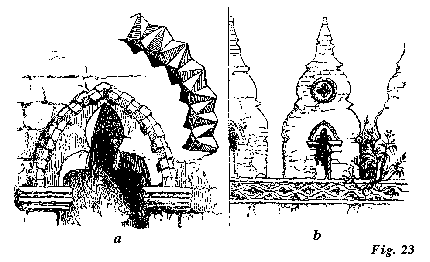282 THE STONES OF VENICE
the arch. The moulding of the brick is throughout sharp and beautiful in the highest degree. One of the most curious points about it is the careless way in which the curved outlines of the pinnacles are cut into the plain brickwork with no regard whatever to the places of its joints. The weather of course wears the bricks at the exposed joints, and jags the outline a little; but the work has stood, evidently from the fourteenth century, without sustaining much harm.
§ 13. This parapet may be taken as a general type of the wall-parapet of Venice in the Gothic period; some being
 |
much less decorated, and others much more richly; the most beautiful in Venice is in the little Calle, opening on the Campo and Traghetto San Samuele; it has delicately carved devices in stone let into each pinnacle.
The parapets of the palaces themselves were lighter and more fantastic, consisting of narrow lance-like spires of marble, set between the broader pinnacles, which were in such cases generally carved into the form of a fleur-de-lis: the French word gives the reader the best idea of the form, though he must remember that this use of the lily for the parapets has nothing to do with France, but is the carrying out of the Byzantine system of floral ornamentation, which introduced the outline of the lily everywhere; so that I
1 [In his copy for revision Ruskin has noted at the side of Fig. 23, “Confer Deuteronomy xxii. 8”-“When thou buildest a new house, then thou shalt make a battlement for thy roof, that thou bring not blood upon thine house, if any man fall from thence.”]
[Version 0.04: March 2008]